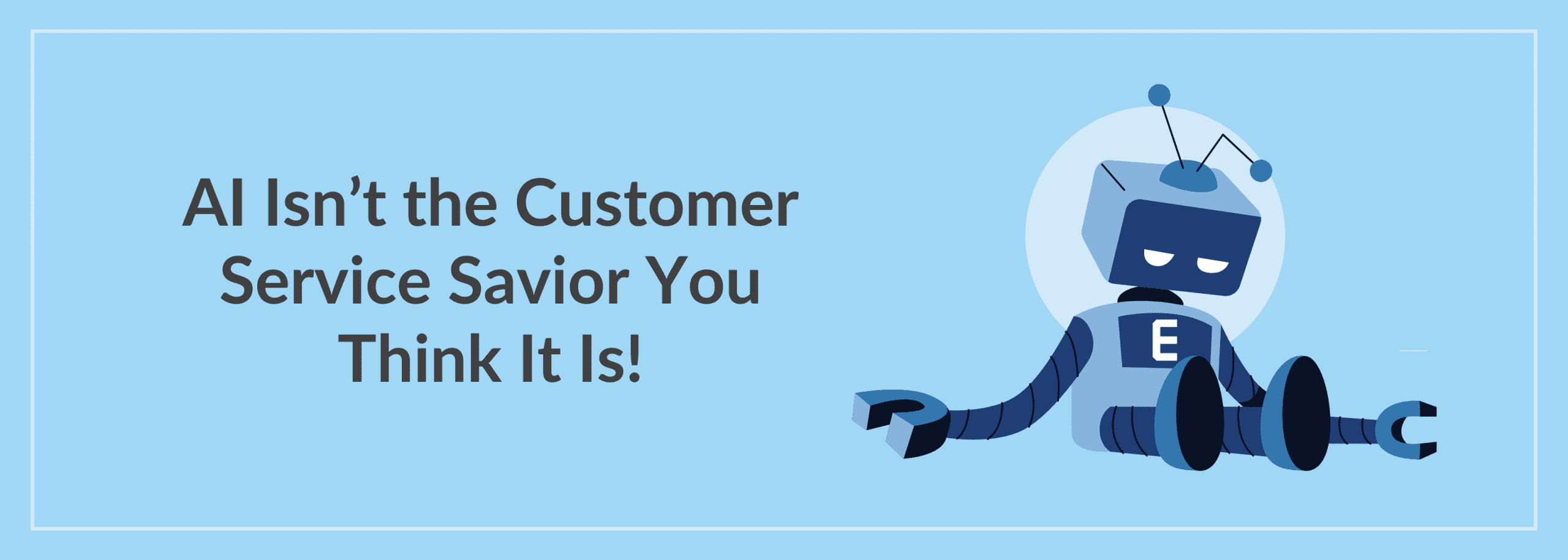AI in Customer Service: Enhancing, Not Replacing, Humans
I visited a neighborhood supermarket this morning. I picked up a coffee powder and headed to the billing counter.
Out of five counters, only one was open, and the line was long. Not wanting to wait, I approached the floor manager and asked if they could open a couple more counters to ease the crowd.
This was his response:
The rest of the staff are currently undergoing process training on how to stack fruits and vegetables more efficiently, which will make it easier for customers to pick them up.
I stood there, coffee powder in hand, thinking, “Seriously?”
If human beings can be this rigid in their responses, imagine how AI-enabled bots that are programmed to follow strict protocols would handle similar situations.
Let me give you a classic real-world example of how AI went wrong.
Klarna, the buy now pay later (BNPL) giant, was initially lauded for its AI assistant that could handle the work of 700 agents. But fast forward a year, and the praise turned into backlash as customer service deteriorated.
Klarna’s CEO recently admitted that while AI may have driven operational efficiency, it came at the cost of human connection.
This is what the CEO of Klarna said:
In a world of AI, nothing will be as valuable as humans. You can laugh at us for realizing it so late, but we’re going to Kick off work to allow Klarna to become the best at offering a human to speak to.
And that’s a powerful realization.
If you want to explore more AI applications that enhance customer experience and free up agent time, check out AI Use Cases Driving Customer Experience
What Companies Must Know Before Implementing AI in Customer Support
AI is only valuable when it assists or supports humans, not replaces them. Let us break down how businesses can maintain that balance while implementing AI.
AI alone cannot be the answer.
Let me give you a few case examples.
Example 1
One of our fintech customers implemented an AI-powered chatbot to handle customer interactions. They were handling about 70% of their customer interactions using the chatbot.
Initially, there was euphoria, and they saw encouraging results like improved response times and reduced costs. However, customers soon started to complain as the chatbots did not understand the complex queries from their customers, which led to frustration.
They then had to relook at their AI strategy.
They did an audit and ensured that the chatbots handled only the repetitive transactional queries and seamlessly directed all the nuanced queries to human agents.
This was the balance that worked for them, where AI handled all the mundane stuff while ensuring that customers received empathetic human support.
Example 2
One of our banking customers implemented a hybrid AI model where chatbots handle initial inquiries and human agents step in for escalations.
AI acted as the first line of support. Besides, AI empowered agents with real-time insights through data-driven recommendations, sentiment analysis, and next-best-action prompts. This helped the agents handle the escalations effectively.
Example 3
One of our customers in the travel space implemented an AI-only approach during the peak
holiday season.
They faced backlash from their customers as their AI assistants could not give quick resolutions to urgent travel issues. Most of their customers were stuck in endless loops, which resulted in a lot of frustration.
Realizing this, they pulled the plug on their AI-only approach.
While they had AI as a part of their support, they offered a way for their customers to connect with a human agent at any point during their interactions.
This helped them considerably improve their customer experience.
The Future of AI in Customer Experience:
AI is everywhere. From chatbots to voice assistants, AI is transforming how businesses handle customer service.
While AI has proven to be a cost-cutting powerhouse, it’s not always a customer service miracle worker.
You have to strike the right balance to make AI work its magic on customer service.
4 Steps to Balance AI and Human Support in Customer Service
- Identify which tasks can be handled by AI and which require human intervention. Segment them nicely before you start with your AI implementation.
- Use AI to analyze interactions and gather key insights, but let agents handle the nuanced and emotional conversations. This would help agents handle escalations easily with AI-driven insights.
- Make it easy for customers to connect with a human agent when AI cannot resolve their issues. Make this seamless for customers to choose at any point in their interactions.
- Train agents to leverage the power of AI tools effectively. This would help not just in resolving customer issues but also in building rapport and providing exceptional service.
What was the most common headline in the initial days of AI hype?
AI will replace 40% of customer service jobs by 2025.
This is clickbait, but beyond that, it doesn’t do any justice.
This narrative makes sense when businesses consider customer service and support as a cost center. But, when you start to look at contact centers as a profit center, then your approach will have to change.
We have seen examples of many organizations pivoting back to human-centric service in the recent past. This is a wake-up call for companies relying too heavily on AI at the expense of genuine customer interactions.
The most important question that you should ask yourself is:
Are you using AI to reduce costs or to elevate the customer experience genuinely?
If it is the latter, you are on the right track.
Your end goal should be to elevate and enhance the customer experience. So, empower yourself with AI-driven insights and use AI’s help to handle routine and transactional interactions.
An AI-first approach is acceptable, but don’t make it an AI-only approach.
